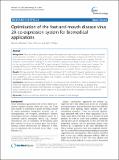Files in this item
Optimisation of the foot-and-mouth disease virus 2A co-expression system for biomedical applications
Item metadata
| dc.contributor.author | Minskaia, Ekaterina | |
| dc.contributor.author | Nicholson, John | |
| dc.contributor.author | Ryan, Martin Denis | |
| dc.date.accessioned | 2013-08-28T09:31:01Z | |
| dc.date.available | 2013-08-28T09:31:01Z | |
| dc.date.issued | 2013-08-22 | |
| dc.identifier | 67129967 | |
| dc.identifier | 2ae20532-3b5e-4b1d-9913-bd6a52fdddaf | |
| dc.identifier | 84882998955 | |
| dc.identifier.citation | Minskaia , E , Nicholson , J & Ryan , M D 2013 , ' Optimisation of the foot-and-mouth disease virus 2A co-expression system for biomedical applications ' , BMC Biotechnology , vol. 13 , 67 . https://doi.org/10.1186/1472-6750-13-67 | en |
| dc.identifier.issn | 1472-6750 | |
| dc.identifier.other | ORCID: /0000-0002-0012-0614/work/47136052 | |
| dc.identifier.uri | https://hdl.handle.net/10023/4008 | |
| dc.description | This work was supported by the Medical Research Council. | en |
| dc.description.abstract | Background Many biomedical applications require the expression or production of therapeutic hetero-multimeric proteins/protein complexes: in most cases only accomplished by co-ordinated co-expression within the same cell. Foot-and-mouth disease virus 2A (F2A) and ‘2A-like’ sequences are now widely used for this purpose. Since 2A mediates a co-translational ‘cleavage’ at its own C-terminus, sequences encoding multiple proteins (linked via 2As) can be concatenated into a single ORF: a single transgene. It has been shown that in some cases, however, the cleavage efficiency of shorter versions of F2A may be inhibited by the C-terminus of certain gene sequences immediately upstream of F2A. This paper describes further work to optimise F2A for co-expression strategies. Results We have inserted F2A of various lengths in between GFP and CherryFP ‘reporter’ proteins (in reciprocal or tandem arrangements). The co-expression of these proteins and cleavage efficiencies of F2As of various lengths were studied by in vitro coupled transcription and translation in rabbit reticulocyte lysates, western blotting of HeLa cell lysates and fluorescence microscopy. Conclusions Optimal and suboptimal lengths of F2A sequences were identified as a result of detailed ‘fine-tuning’ of the F2A sequence. Based on our data and the model according to which 2A activity is a product of its interaction with the exit tunnel of the ribosome, we suggest the length of the F2A sequence which is not ‘sensitive’ to the C-terminus of the upstream protein that can be successfully used for co-expression of two proteins for biomedical applications. | |
| dc.format.extent | 1806085 | |
| dc.language.iso | eng | |
| dc.relation.ispartof | BMC Biotechnology | en |
| dc.subject | Protein co-expression | en |
| dc.subject | Bicistronic vector | en |
| dc.subject | Co-translational ‘self-cleavage’ | en |
| dc.subject | QR355 Virology | en |
| dc.subject.lcc | QR355 | en |
| dc.title | Optimisation of the foot-and-mouth disease virus 2A co-expression system for biomedical applications | en |
| dc.type | Journal article | en |
| dc.contributor.sponsor | Medical Research Council | en |
| dc.contributor.institution | University of St Andrews. Biomedical Sciences Research Complex | en |
| dc.contributor.institution | University of St Andrews. School of Biology | en |
| dc.identifier.doi | 10.1186/1472-6750-13-67 | |
| dc.description.status | Peer reviewed | en |
| dc.identifier.grantnumber | G0901002 | en |
This item appears in the following Collection(s)
Items in the St Andrews Research Repository are protected by copyright, with all rights reserved, unless otherwise indicated.

